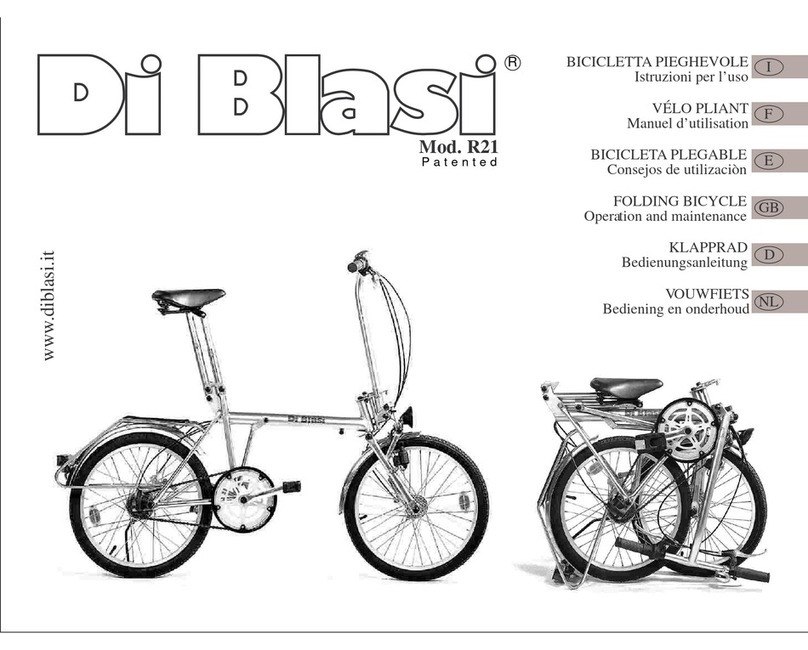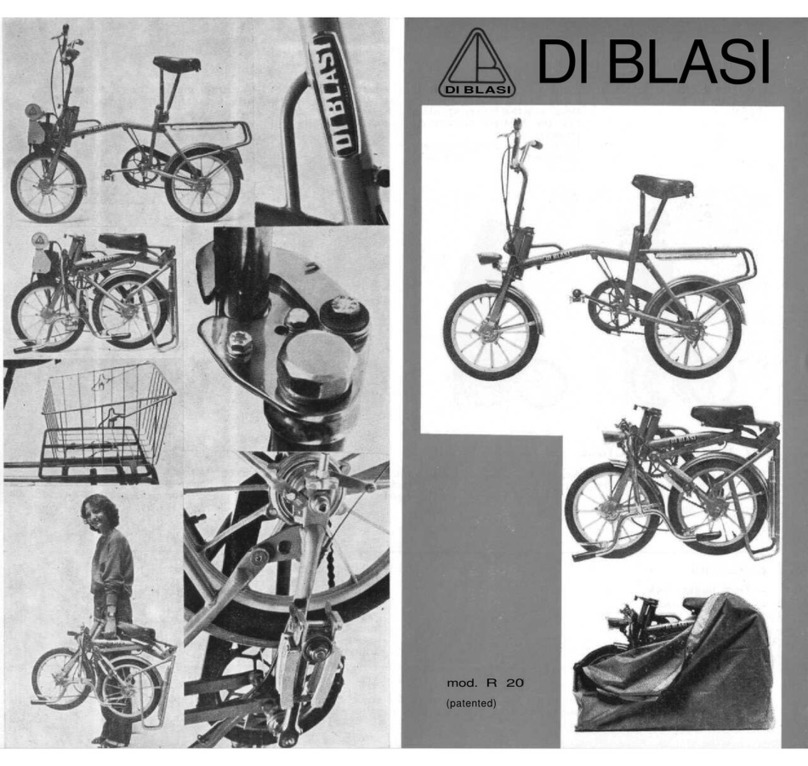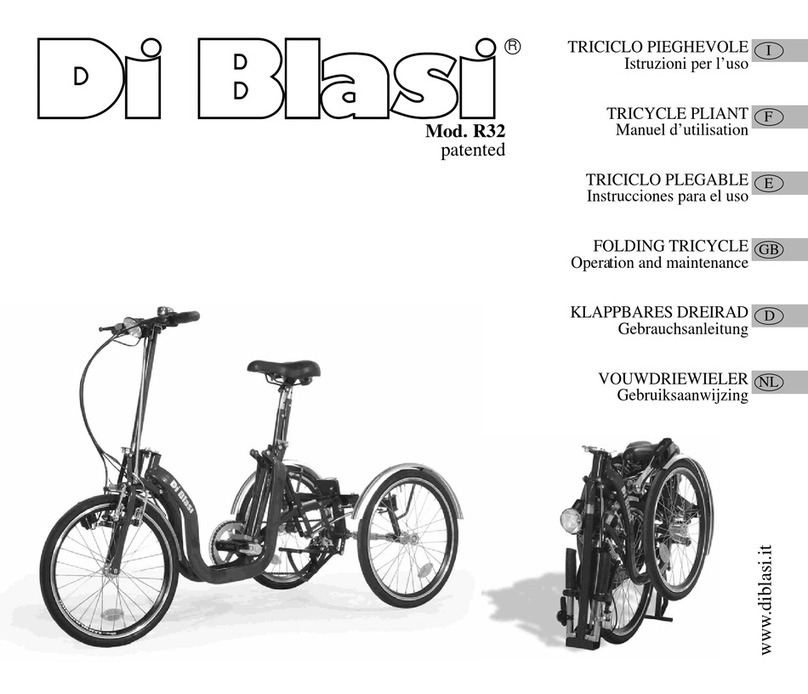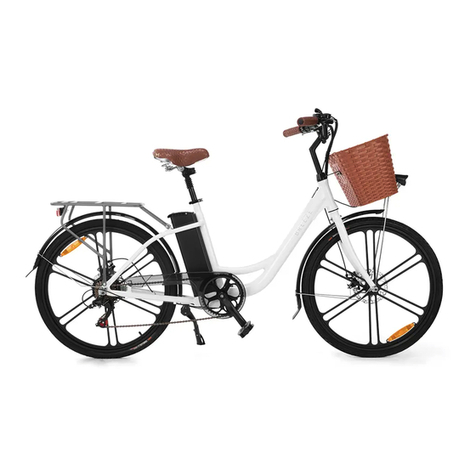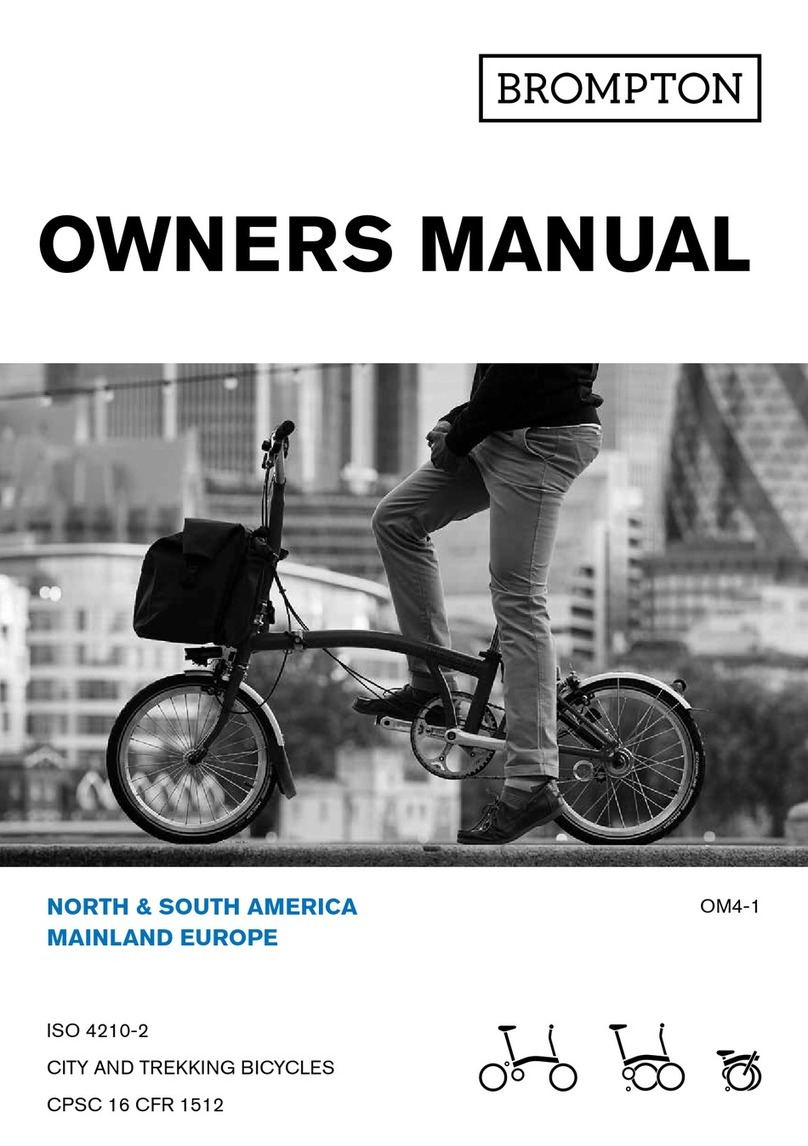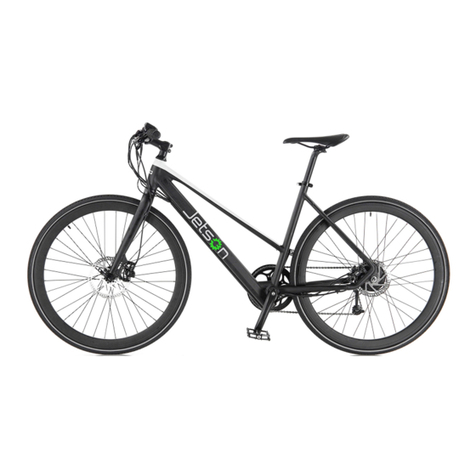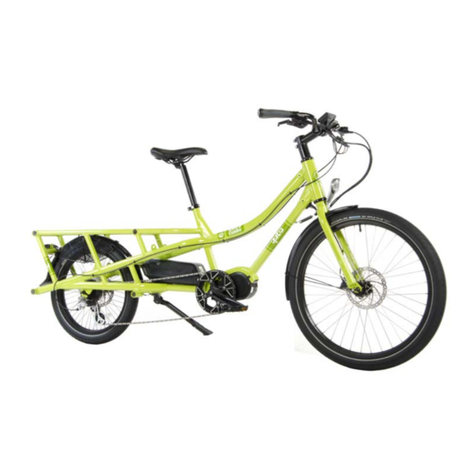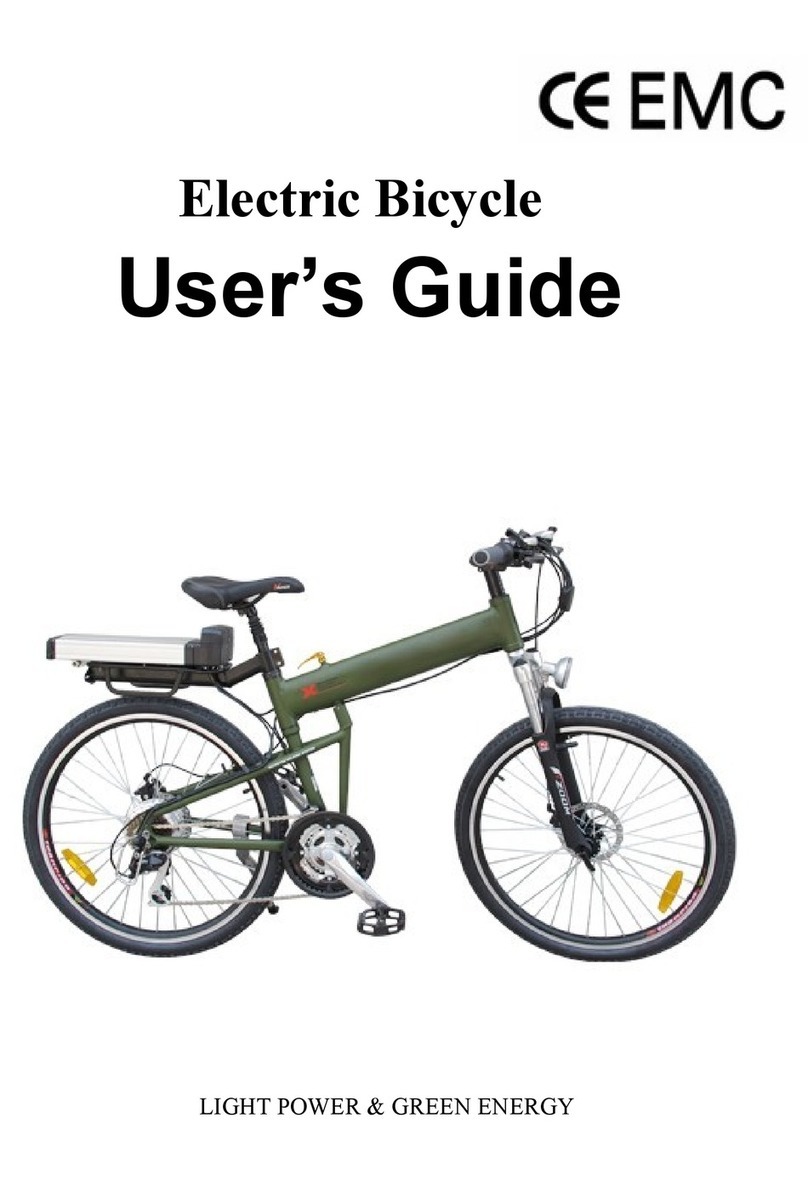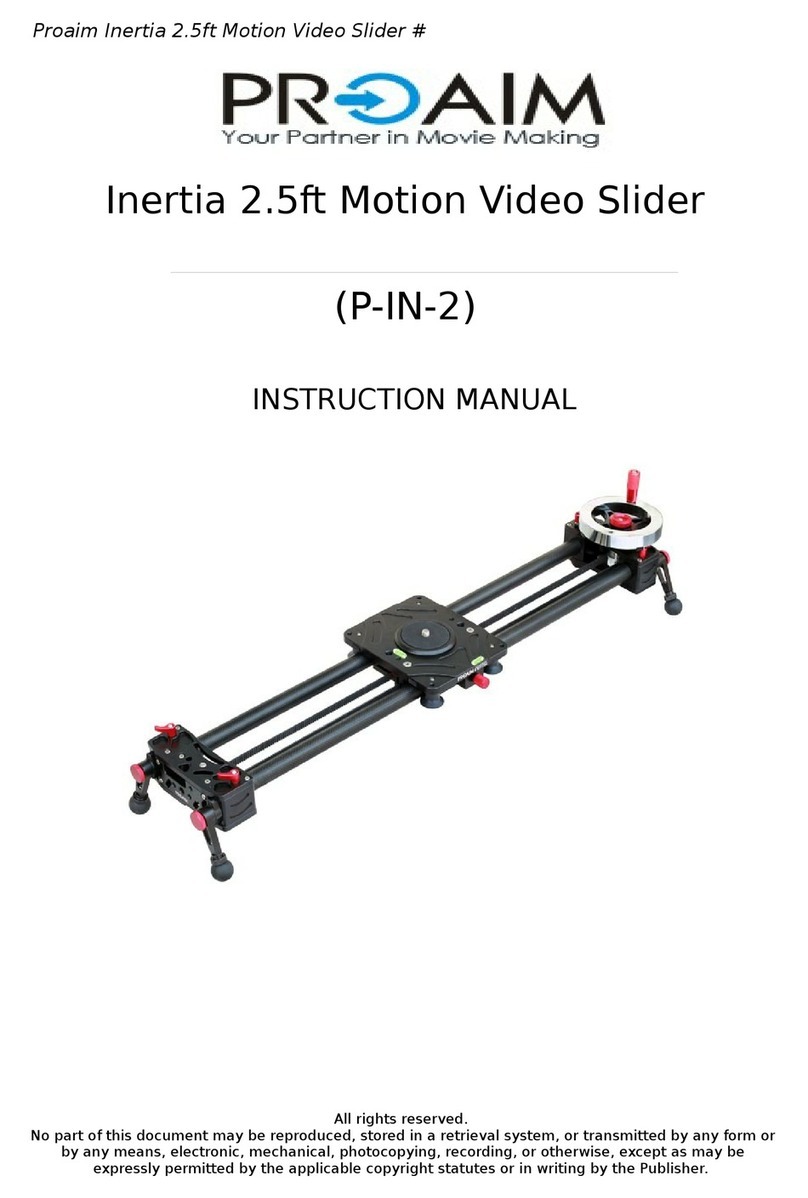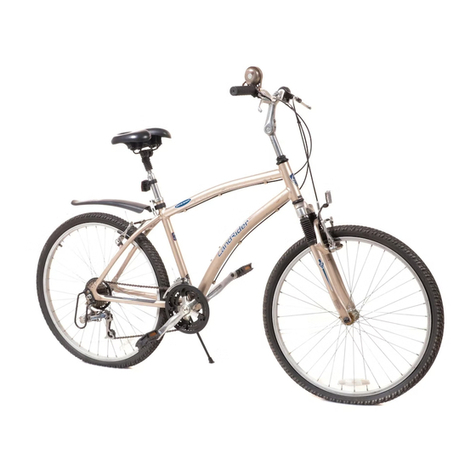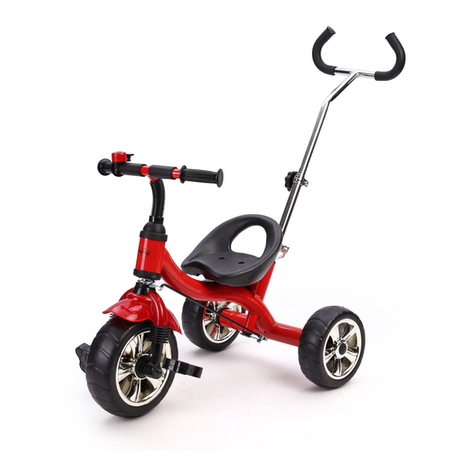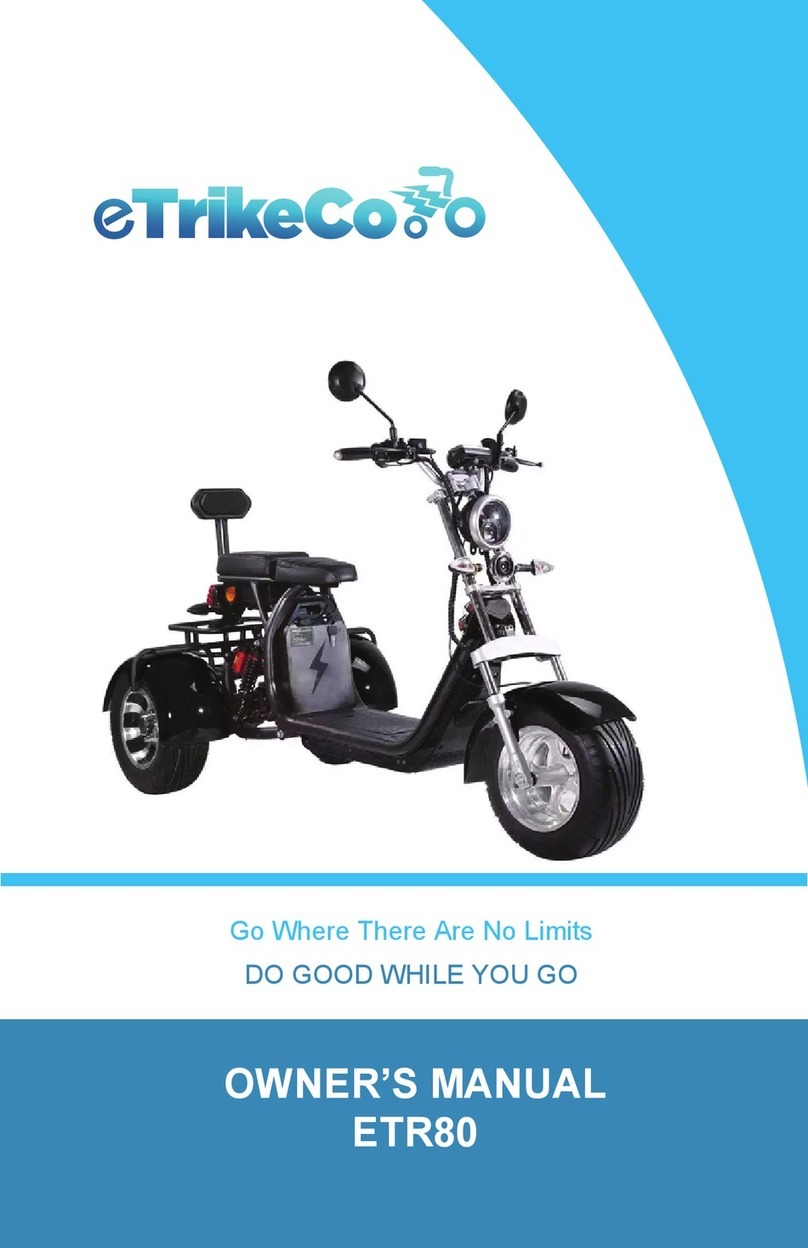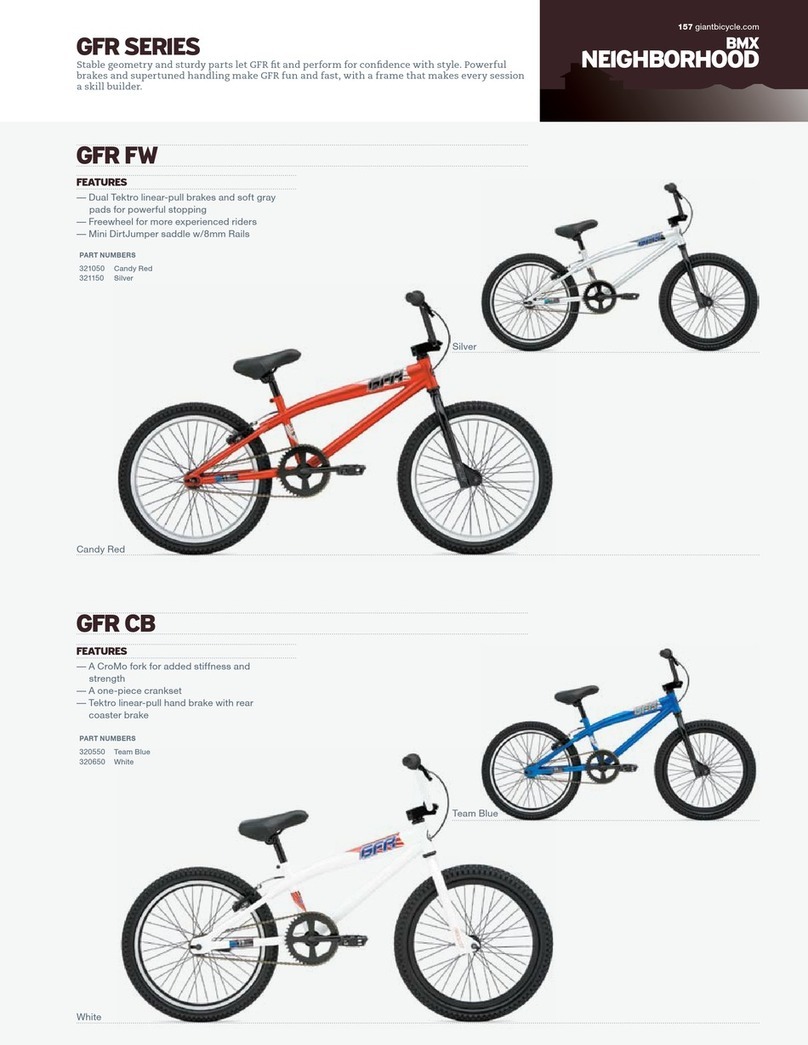DI BLASI R31 Installation guide

GB
D
NL
I
F
E
R
Mod. R31
patented
www.diblasi.it
TRICICLO PIEGHEVOLE
Istruzioni per l’uso
TRICYCLE PLIANT
Manuel d’utilisation
TRICICLO PLEGABLE
Instrucciones para el uso
FOLDING TRICYCLE
Operation and maintenance
KLAPPBARES DREIRAD
Gebrauchsanleitung
VOUWDRIEWIELER
Gebruiksaanwijzing

I F E
AVVERTENZA
Prima di condurre il triciclo DI BLASI, effettuare
i controlli di sicurezza prescritti in questo
manuale.
Questo triciclo non può essere utilizzato su
percorsi fuori strada, per corse, per trasporto
merci, ecc..: esso può essere utilizzate solo come
normale triciclo da passeggio.
NORME DI PRUDENZA
• Rispettare scrupolosamente il codice della
strada e le norme di prudenza.
• Ridurre la velocità nelle strade in discesa o
con fondo sconnesso.
• Evitare manovre brusche o azzardate.
• Fare attenzione ai veicoli motorizzati.
• Tenere presente che su strada bagnata la
distanza di frenata aumenta
considerevolmente.
• Non andare sulla neve o su ghiaccio.
• Permettere ai bambini di andare sul triciclo
solo se hanno un’età adeguata e solo dopo
che un adulto ha effettuato i necessari
controlli di sicurezza.
Il triciclo può portare solo una persona.
CONSEILS D’UTILISATION
Avantdeconduireletricycle DIBLASI,effectuez
les contrôles de sécurité prescrits dans ce Manuel
d’Utilisation et tenez compte qu’il ne doit pas
être utilisée sur parcours non routiers, ou comme
tricycle de course, ou pour des transports lourds:
il peut être utilisé seulement comme un tricycle
de tourisme normale.
NORMES DE PRUDENCE
• Respectez scrupuleusement le code de la
route et les notions de prudence.
• Réduisez la vitesse en descente ou si le
revêtement routier n’est pas en bon état.
• Evitez les manoeuvres précipitées et brutales.
• Faire attention aux véhicules motorisés.
• Faire attention que si la chaussée est mouillée
ou polluée les distances de freinage peuvent
augmenter de façon considérable.
• Ne roulez pas sur la neige ni sur le verglas.
• Ne laissez pas les enfants partir sans contrôler
le bon état du tricycle et sans avoir effectué
les contrôles de sécurité.
Le tricycle peut transporter seulement une
personne.
ADVERTENCIA
Antes de conducir el triciclo DI BLASI, efectuar
los controles de seguridad pre-escritos en este
manual.
Este triciclo no puede ser utilizado en recorridos
de terracería, para carreras, para transportar
mercancía, etc.: éste puede ser utilizado solo
como un normal triciclo de paseo.
NORMAS DE PRUDENCIA
• Respetar escrupulosamente el código del
tránsito y las normas de prudencia.
• Reducir la velocidad en las calles en bajada
o con asfalto arruinado.
• Evitar maneobras bruscas o azardadas.
• Tener cuidado con los vehículos motorizados.
• Tener presente que en carretera mojada la
distancia de frenada aumenta
consideradamente.
• No usarlo en la nieve o en el hielo.
• Permitir a los niños de ir en el triciclo sólo
si tienen una edad adecuada y sólo después
de que un adulto ha efectuado los controles
necesarios de seguridad.
El triciclo lo puede llevar sólo una persona.

GB D NL
IMPORTANT NOTICES
Before riding the DI BLASI tricycle, carry out all
the safety checks prescribed in this manual.
This tricycle must not be used as an off road, or
as a racing or as a carrier tricycle: it can be used
only as a normal touring tricycle.
RIDING RULES
• Obey all traffic signals and regulations and
ride with caution.
• Reduce the speed in downhill or bad roads.
• Avoid abrupt manoeuvring and zig zag. riding.
• Be on guard for all motorized vehicles.
• Pay attention that if the road is wet the braking
distance can increase considerably.
• Do not ride on snow or on gravel road.
• Allow the children to ride the tricycle only if
they are grown-up enough and only after that
an adult carried out the safety checks.
The tricycle is built only for one rider, never
ride two.
HINWEIS
Bevor Sie das DI BLASI Dreirad verwenden,
müssen Sie die in diesem Handbuch
vorgeschriebenen Sicherheitskontrollen
durchführen.
Dieses Dreirad darf nicht für Geländestrecken,
Rennen, Gütertransport usw., sondern nur als
normales Dreirad zum Spazieren fahren
verwendet werden.
VORSICHTSANWEISUNGEN
• Die Straßenverkehrordnung und
Vorsichtsanweisungen genauestens einhalten.
• Auf Straßen mit Gefällen oder unebenem
Untergrund die Geschwindigkeit reduzieren.
• Keine plötzlichen oder riskanten Manöver
ausführen.
• Die Fahrzeuge mit Motor beachten.
• Beachten Sie, dass auf der nassen Straße der
Bremsweg viel länger ist.
• Nicht mit dem Dreirad auf Schnee oder Eis
fahren.
• Kinder dürfen das Dreirad nur verwenden,
wenn sie alt genug sind und nachdem ein
Erwachsener die erforderlichen
Sicherheitskontrollen ausgeführt hat.
Das Dreirad kann nur eine Personbefördern.v
WAARSCHUWING
Voer de veiligheidscontroles die in deze
handleiding staan beschreven uit voordat u met
de DI BLASI driewieler gaat rijden.
Dezedriewielerisnietgeschikt voorterreinrijden,
wielrennen,goederentransport, enz.:dedriewieler
is alleen bedoeld voor gebruik als normale
toerfiets.
VEILIGHEIDSVOORSCHRIFTEN
• Houd u aan de verkeersregels en de
veiligheidsvoorschriften.
• Verminder uw snelheid op aflopende wegen
of op wegen met een slecht wegdek.
• Vermijd plotselinge of gevaarlijke
manoeuvres.
• Let goed op gemotoriseerde voertuigen.
• Denk eraan dat op natte wegen de remweg
aanzienlijk langer is.
• Rijd niet op sneeuw of ijs.
• Laat kinderen alleen op de driewieler rijden
als ze daar de leeftijd voor hebben en nadat
een volwassene de benodigde
veiligheidscontroles heeft uitgevoerd.
De driewieler is geschikt voor het dragen
van slechts één persoon

I F E
INDICE
Aprire il triciclo 2
Campanello 5.9
Caratteristiche tecniche 1
Cerniera del manubrio: regolazione 5.2
Deragliatore: modalità d’uso 4.4
Deragliatore: regolazione 5.5
Freni: modalità d’impiego 4.3
Freni: regolazioni e manutenzione 5.6
Gancio manubrio: regolazioni 5.1
Gonfiaggio dei pneumatici 5.4
Guarnitura: regolazioni 5.8
Luci 4.5
Manubrio: regolazione cerniera 5.2
Manubrio: regolazione gancio 5.1
Manutenzione 6
Modalità d’uso 4
Pedali 4.2
Pneumatici: pressione 5.4
Ripiegare il triciclo 3
Ruote: regolazioni cuscinetti 5.7
Sellino: regolazione altezza 5.3
Trasmissione: modalità d’uso 4.4
Trasmissione : regolazioni 5.5
Regolazioni 5
INDEX
Caractéristiques techniques 1
Charnière du guidon: réglage 5.2
Conduite 4
Crochet du guidon: réglage 5.1
Déplier le tricycle 2
Dérailleur: mode d’emploi 4.4
Dérailleur: réglages 5.5
Eclairage 4.5
Entretien 6
Freins: mode d’emploi 4.3
Freins: réglage et entretien 5.6
Guidon: charnière 5.2
Guidon: crochet 5.1
Pédales 4.2
Pédalier: réglages 5.8
Plier le tricycle 3
Pneus: gonflage 5.4
Réglages 5
Roues: réglage 5.7
Selle: réglage 5.3
Sonnette 5.9
Transmission: mode d’emploi 4.4
Transmission: réglages 5.5
INDICE
Abrir el triciclo 2
Timbre 5.9
Características técnicas 1
Cierre del Timón: regulación 5.2
Descarrillador: modalidad de uso 4.4
Descarrillador: regulación 5.5
Frenos: modalidad de empleo 4.3
Frenos: regulación y manutención 5.6
Gancho timón: regulaciones 5.1
Inflado de neumáticos 5.4
Guarnición: regulaciones 5.8
Luces 4.5
Timón: regulación faja 5.2
Timón: regulación gancho 5.1
Manutención 6
Modalidad de uso 4
Pedales 4.2
Neumáticos: presión 5.4
Plegar el triciclo 3
Ruedas: regulaciones cojinetes 5.7
Sillón: regulación altura 5.3
Transmisión: modalidad de uso 4.4
Transmisión : regulaciones 5.5
Regulaciones 5

GB D NL
INDEX
Adjustments 5
Approach the tricycle 4.1
Brake adjustment and maintenance 5.6
Brake operation 4.3
Crankset adjustment 5.8
Derailleur adjustment 5.5
Derailleur operation 4.4
Folding the tricycle 3
Gear ratio adjustments 5.5
Gear ratio operation 4.4
Handlebar hinge adjustment 5.2
Handlebar hook adjustment 5.1
Lighting 4.5
Maintenance 6
Night-time operation 4.5
Operations 4
Pedals 4.2
Seat height adjustment 5.3
Technical specifications 1
Tyre pressure 5.4
Unfolding the tricycle 2
Wheel bearing adjustment 5.7
INHALTSVERZEICHNIS
Dreirad aufklappen 2
Glocke 5.9
Technische Daten 1
Lenkstangengelenk: Einstellung 5.2
Kettenschaltung: Gebrauchsanweisung 4.4
Kettenschaltung: Einstellung 5.5
Bremsen: Verwendungsweise 4.3
Bremsen: Nachstellungen und Wartung 5.6
Lenkstangenhaken: Einstellungen 5.1
Reifen aufpumpen 5.4
Beschlag: Einstellungen 5.8
Lichter 4.5
Lenkstange: Gelenkeinstellung 5.2
Lenkstange: Hakeneinstellung 5.1
Wartung 6
Gebrauchsanweisung 4
Pedale 4.2
Reifen: Reifendruck 5.4
Dreirad zusammenklappen 3
Räder: Lagerregulierung 5.7
Sitz: Höhenverstellung 5.3
Antrieb: Gebrauchsanweisung 4.4
Antrieb: Einstellungen 5.5
Einstellungen 5
INHOUD
De driewieler openvouwen 2
Bel 5.9
Technische eigenschappen 1
Scharnier van het stuur: afstellen 5.2
Derailleur: gebruiksaanwijzing 4.4
Derailleur: afstellen 5.5
Remmen: gebruiksaanwijzing 4.3
Remmen: afstellen en onderhoud 5.6
Borghaak stuur: afstellen 5.1
De banden oppompen 5.4
Kettingset: afstellen 5.8
Verlichting 4.5
Stuur: scharnier afstellen 5.2
Stuur: borghaak afstellen 5.1
Onderhoud 6
Gebruiksaanwijzing 4
Pedalen 4.2
Banden: druk 5.4
De driewieler dichtvouwen 3
Wielen: lagers afstellen 5.7
Zadel : hoogte afstellen 5.3
Aandrijving: gebruiksaanwijzing 4.4
Aandrijving : afstellen 5.5
Afstellen 5

I F E
* Dimensioni
• Ripiegato: cm 66x30x63 (h)
• Aperto:
- Passo: 91 cm
- Carreggiata: 64 cm
* Peso: 19,4 kg circa
* Pneumatici: 16 x 1.75 x 2
* Ruote con raggi inox e cerchi in lega
leggera
* Guarnitura: 42 denti - 170 mm
* Trasmissione: a catena con deragliatore
e ruota libera a 7 pignoni (13/28)
* Freni: due freni anteriore ad espansione
con tamburo Ø 70 mm.
Dispositivo di parcheggio operante su
uno dei due freni.
* Sellino regolabile in 4 posizioni
- Altezza dal suolo:
min 84 cm – max 98 cm
- Altezza dal pedale più basso:
min 75 cm – max 89 cm
Optional: sellino più basso
* Carico massimo: 100 kg
* Portapacchi posteriore (accessorio):
- Dimensioni: 34 x 28 cm
- Carico massimo: 10 kg
* Dimensions
• Plié: cm 66x30x63 (h)
• Déplié:
- Empattement : 91 cm
- Voie: 64 cm
* Poids: 19,4 kg environ
* Pneus: 16 x 1.75 x 2
* Roues: rayons inox et jantes en alliage
léger
* Pédalier: 42 dents – 170 mm
* Transmission: par chaine avec dérailleur
et roue libre a 7 pignons (13/28)
* Freins: deux freins à expansion sur la
roue avant avec tambour Ø 70 mm.
Dispositif de parking agissant sur un des
deux freins.
* Selle réglable en 4 positions.
- Hauteur du sol :
min 84 cm – max 98 cm
- Hauteur de la pédale plus basse:
min 75 cm – max 89 cm
Optionnel : selle plus basse
* Charge maximum: 100 kg
* Porte bagage arrière (accessoire)
- Dimensions: 34 x 28 cm
- Charge maximum: 10 kg
* Dimensiones
• Plegado: cm 66x30x63 (h)
• Abierto:
- Paso: 91 cm
- Calzada: 64 cm
* Peso: 19,4 kg aprox.
* Neumáticos: 16 x 1.75 x 2
* Ruedas con rayos inox y círculos aleados
ligeramente
* Guarnición: 42 dientes - 170 mm
* Transmisión: a cadena con descarrillador
y rueda libre a 7 piñones (13/28)
* Frenos: dos frenos anterior a expansión
con tambor Ø 70 mm.
Dispositivo de parqueo funcionante en
uno de los dos frenos.
* Sillín de 4 posiciones ajustable
- Altura desde el suelo:
mín. 84 cm – máx. 98 cm
- Altura desde el pedal más bajo:
mín. 75 cm – máx. 89 cm
Opcional: sillín más bajo
* Carga máxima: 100 kg
* Portapaquetes posterior (accesorio):
- Dimensiones: 34 x 28 cm
- Carga máxima: 10 kg
1. CARATTERISTICHE TECNICHE 1.CARACTERISTIQUES TECNIQUES 1. CARACTERÍSTICAS TÉCNICAS

GB D NL
* Dimensions
• Folded: cm 66x30x63 (h)
• Unfolded:
- Wheelbase: 91 cm
- Track: 64 cm
* Weight: 19,4 kg approx
* Tyres: 16 x 1.75 x 2
* Wheels: stainless steel spokes and light
alloy rims
* Chainset: 42 teeth - 170 mm
* Chain drive with index derailleur and 7
sprockets freewheel (13/28)
* Brakes: two expanding brakes on the
front wheel with Ø 70 mm drum.
Parking device acting on one of the two
brakes.
* Seat adjustable in four positions.
- Height from the ground:
min 84 cm (33,07”)
max 98 cm (38,58”)
- Height from the lowest pedal:
min 75 cm (29,53”)
max 89 cm (35,04”)
Optional: lower seat
* Max load: 100 kg
* Rear carrier (accessory):
- Dimensions: 34 x 28 cm
- Max load: 10 kg
* Ausmaß
• Zusammengeklappt 66x30x63 (h) cm
• Offen:
- Radstand: 91 cm
- Spurweite: 64 cm
* Gewicht: zirka 19,4 kg
* Reifen: 16 x 1,75 x 2
* Räder mit Edelstahlspeichen und
Leichtmetallfelgen
* Beschlag: 42 Zähne – 170 mm
* Antrieb: Kettenantrieb mit
KettenschaltungundFreilaufmit 7Ritzel
(13/28)
* Bremsen: Zwei vordere
Innenbackenbremsen mit einer 70 mm
Trommel.
Parkvorrichtung, die auf eine der beiden
Bremsen einwirkt.
* Sattel, verstellbar in 4 Positionen:
−Höhe ab Boden:
min. 84 cm – max. 98 cm
−Höhe ab Pedal unten:
min. 75 cm – max. 89 cm
Optional: niedrigerer Sattel
* Höchstbelastung: 100 kg
* Rückwärtiger Gebäckträger (Zubehör):
- Ausmaß: 34 x 28 cm
- Höchstbelastung: 10 kg
* Afmetingen
• Opgevouwen: cm 66 x 30 x 63 (h)
• Open:
- Wielbasis: 91 cm
- Spoorbreedte: 64 cm
* Gewicht: Circa 19,4 kg
* Banden: 16 x 1,75 x 2
* Wielen met r.v.s. spaken en velgen van
lichtmetaallegering
* Kettingset: 42 tanden – 170 mm
* Aandrijving: via ketting met derailleur
en freewheel met 7 versnellingen (13/28)
* Remmen: twee trommelremmen voor
met trommel Ø 70 mm.
Parkeerrem op één van de twee remmen.
* In 4 posities verstelbare hoogtes van het
zadel
- Hoogte vanaf de grond:
minimaal 84 cm – maximaal 98 cm
- Hoogte vanaf het laagste pedaal:
minimaal 75 cm – maximaal 89 cm
Optie: een lager zadel
* Maximale belasting: 100 kg
* Bagagedrager achter (optioneel):
- Afmetingen: 34 x 28 cm
- Maximale belasting: 10 kg
1. TECHNISCHE DATEN 1. TECHNISCHE KENMERKEN1. SPECIFICATIONS

I F E
2. PER APRIRE ILTRICICLO
Quando il triciclo è ripiegato, esso sta in piedi
poggiato sul cavalletto (fig.1).
Alzare il manubrio e spingerlo con decisione
contro il gancio posto sulla sommità della forcella
dove deve restare bloccato in posizione verticale.
Assicurarsi che il piantone del manubrio
aderisca completamente e senza gioco alla
parte interna del gancio e che la molla che
tira il gancio agisca efficacemente.
(ved. Cap. 5.1) (fig.2).
Liberare il telaio dal gancio posto vicino alla
pedivella sinistra (fig.3) e, dopo che le pedivelle
si sono abbassate di circa 5 cm, tirare la sella
prima verso l'alto e poi indietro finché il triciclo
resta bloccato in posizione aperta dal gancio
posto a sinistra dei tubi reggisella (fig.4).
Aprire i pedali (ved. Cap. 4.2)
Prima di partire, effettuare i controlli di sicurezza,
in particolare quelli di cui ai cap. 4.2 e 5.1.
2. POUR DEPLIER LE TRICYCLE
Quand le tricycle est plié, il tient debout sur sa
béquille (fig.1).
Relevez le guidon et poussez le franchement
dans son crochet d’arrêt (claquement net) où il
doit rester bloqué verticalement. Assurez vous
que le crochet adhère completement et sans
jeu à la colonne du guidon et que le ressort
qui tire sur le crochet soit bien actif (voir 5.1)
(fig.2).
Soulevez le crochet situé prés de la manivelle
gauche (fig.3) et, aprés que le pédalier a baissé
d’environs 5 cm, tirez la selle vers le haut et
puis vers l’arrière jusqu’à encliqueter le crochet
de sécurité placé à gauche des colonnes de la
selle (claquement sec) (fig.4).
Dépliez les pédales (voir 4.2)
Avant de rouler, effectuez les contrôles de
sécurités, en particulier ceux dont aux par. 4.2
et 5.1
2. PARAABRIR ELTRICICLO
Cuando el triciclo está plegado, éste está de pie
apoyado sobre el caballete (fig.1).
Levantar el timón y empujarlo con decisión
contra el gancho puesto sobre la cima de la
horquilla donde debe quedarse bloqueado en
posición vertical. Asegurarse que el plantón
del timón se adhiera completamente y sin que
baile con la parte interna del gancho y que el
resorte que jala el gancho funcione
eficazmente. (ver Cap. 5.1) (fig.2).
Liberar el chasis del gancho puesto cerca del
pedal izquierdo (fig.3) y después que los pedales
se han bajado de más o menos 5 cm. Jalar el
sillón primero hacia el alto y luego para atrás
hasta que el triciclo quede bloqueado en posición
abierta del gancho puesto a la izquierda de los
tubos que sostienen el sillón (fig.4).
Abrir los pedales (ver Cap. 4.2)
Antes de partir, efectuar los controles de
seguridad, en particular los de los cap. 4.2 e 5.1.
Fig. 1
Abb. 1
Afb. 1
Fig. 2
Abb. 2
Afb. 2

GB D NL
Fig. 3
Abb. 3
Afb. 3
Fig. 4
Abb. 4
Afb. 4
2. TO UNFOLD THE TRICYCLE
When the tricycle is folded, it stands up on its
stand (fig.1).
Lift the handlebar and push it resolutely against
the hook until the stem is locked in the vertical
position. Check that the handlebar hook
adheres to the handlebar stem completely and
without any slack and that the spring pulls
the hook powerfully (see Sec 5.1) (fig.2).
Release the frame hook located near the left
crank (fig.3) and, after that the chainset lowered
for about 5 cm,pull theseatupwardand backward
until the seat posts are locked by the hook on
their left side (fig.4).
Unfold the pedals (see sec. 4.2)
Before riding, carry out the safety checks, in
particular those specified at sec. 4.2 and 5.1
2. DREIRAD ÖFFNEN
Zusammengeklappt steht das Dreirad alleine auf
dem Ständer (abb.1).
Die Lenkstange anheben und fest gegen den
Haken am oberen Ende der Gabel drücken, wo
er in vertikaler Stellung blockiert bleiben muss.
Kontrollieren, dass die Steuersäule der
Lenkstange vollkommen anliegt, ohne dass ein
SpielaufderInnenseitedesHakensvorhanden
ist und die Feder,dieden Hakenzieht, wirksam
eingreift. (Siehe Kap. 5.1) (abb.2).
Das Gestell vom Haken neben der linken
Tretkurbel befreien (abb.3). Nachdem die
Tretkurbeln um zirka 5 cm hinuntergelassen
wurden, den Sitz zuerst nach oben und dann nach
hinten ziehen, bis das Dreirad in der offenen
Position vom Haken auf der linken Seite des
Sitzhalterohrs blockiert wird (abb.4).
Die Pedale öffnen (siehe Kap. 4.2)
Vor dem Öffnen die Sicherheitskontrollen und
vor allem die in den Kap. 4.2 und 5.1
beschriebenen Kontrollen durchführen.
2. DE DRIEWIELER OPENVOUWEN
Als de driewieler dichtgevouwen is, kan hij op
de standaard staan (afb.1).
Til het stuur omhoog en duw het krachtig tegen
de borghaak die op het boveneinde van de vork
zit. Het stuur moet in verticale positie op de haak
geblokkeerdworden.Controleerofdestuurbuis
volledig en zonder speling in de borghaak
vastzit en of de veer die de borghaak aanspant
ook echt werkt. (zie hoofdst. 5.1) (afb.2).
Maak het frame los van de borghaak bij de linker
crank (afb.3).Trek nadat de cranks ongeveer 5 cm
zijngedaaldhetzadeleerstnaarbovenenvervolgens
naarachterentotdatdedriewielerindeopenpositie
wordt geblokkeerd door de borghaak aan de
linkerkant van de zadelbuizen (afb.4).
Open de pedalen (zie hoofdst. 4.2)
Voer voordat u vertrekt de veiligheidscontroles
uit, in het bijzonder de controles uit hoofdst. 4.2
en 5.1.

I F E
3. PER RIPIEGARE ILTRICICLO
Portare le pedivelle in posizione verticale.
Liberare i tubi reggisella dal gancio posto alla loro
sinistra (fig.5) e, tenendo il manubrio dritto,
spingere la sella in avanti e verso il basso finché i
tubi reggisella vengono a contatto con il telaio
sottostante (*); tirare quindi la sella indietro (senza
far strisciare il triciclo sul pavimento) in modo che
iltelaiosipieghiulteriormentefino a restare bloccato
dal gancio vicino alla pedivella sinistra (fig.6).
Liberare il piantone manubrio dal gancio che lo
tiene vincolato alla forcella e abbassarlo in avanti
finché va a toccare il pneumatico (fig.7-8).
Piegare i pedali (Ved. Cap. 4.2)
Il triciclo sta in piedi sul cavalletto.
(*) Se non si riesce ad abbassare la sella, non
forzare ma rimuovere gli ostacoli che ne
impediscono il ripiegamento:
• Un pedale urta contro un parafanghi: girare
le pedivelle in posizione verticale.
• Il cardano della trasmissione è inceppato:
girare un po’la ruota sinistra.
3. POUR PLIER LE TRICYCLE
Portez les manivelles en position verticale.
Déverrouillez le crochet de sécurité situé à gauche
des colonnes de selle (fig.5) et, en tenant le guidon
bien droit, repoussez la selle en avant et puis vers
le bas jusqu’à ce que les colonnes viennent à contact
avec le cadre situé au-dessous (*); tirez donc la
selle en arrière (sans faire glisser le tricycle sur le
sol) de façon à obliger le cadre à completer le
repliement et à rester bloqué par le crochet situé
prés de la manivelle gauche (fig.6).
Déverrouillez le crochet de la colonne du guidon
et basculez le guidon en avant vers le bas jusqu’à
ce qu’il touche le pneu avant (fig.7-8).
Rabattez les pédales (Voir 4.2).
Le tricycle se tient debout sur sa bequille.
(*) Si vous n’arrivez pas à baisser la selle, ne la
forcez pas mais éliminez les obstacles qui
empêchent le repliement :
• Un pédale est coincé contre un guarde-boue:
tournez les manivelles en position verticale.
• Lecardandelatransmission estbloqué: tournez
un peu la roue gauche.
Fig. 5
Abb. 5
Afb. 5
Fig. 6
Abb. 6
Afb. 6
3. PARAPLEGAR ELTRICICLO
Llevar los pedales en posición vertical.
Liberar los tubos que sostienen el sillón del gancho
puesto a su izquierda (fig.5) y teniendo el timón
recto, empujar el sillón para adelante y hacia abajo
hasta que los tubos que sostienen el sillón vengan
a contacto con el chasis inferior (*), jalar entonces
el sillón para atrás (sin arrastrar el triciclo en el
piso) en modo que el chasis se plegue ulteriormente
hasta quedar bloqueado del gancho cercano al pedal
izquierdo (fig.6).
Librar el plantón timón del gancho que lo tiene
vinculado a la horquilla y bajarlo para abajo hasta
que toque el neumático (fig.7-8).
Plegar los pedales (Ver Cap. 4.2)
El triciclo está de pie sobre el caballete.
(*) Si no se logra bajar el sillón, no forzarlo sino
remover los obstáculos que impiden el plegado.
• Un pedal choca contra una acera: voltear los
pedales en posición vertical.
• El cardano de la transmisión está trabado:
voltear un poco la rueda izquierda.

GB D NL
3. DE DRIEWIELER DICHTVOUWEN
Zet de cranks in verticale positie.
Maak de zadelbuizen los van de borghaak aan de
linkerkant ervan (afb.5).Houd het stuur recht en
duw het zadel naar voren en naar beneden totdat
de zadelbuizen in contact komen met het
onderliggende frame (*); trek vervolgens het zadel
naar achteren (zonder de driewieler over de grond
te slepen) zodat het frame nog verder dichtklapt
totdat het geblokkeerd wordt door de borghaak bij
de linker crank (afb.6).
Trek de stuurbuis los van de borghaak waarmee het
stuur aan de vork vastzit en duw hem naar beneden
en naar voren totdat de buis de band raakt (afb.7-8).
Vouw de pedalen op (zie hoofdstuk. 4.2)
De driewieler kan op de standaard staan.
(*) Als het u niet lukt om het zadel naar beneden
te duwen, forceer dit dan niet, maar verwijder
de obstakels die het opvouwen verhinderen:
• Een pedaal stoot tegen een spatbord: draai de
cranks in verticale positie.
• De cardankoppeling van de aandrijving zit
vast: draai een beetje aan het linkerwiel.
3. TO FOLD THE TRICYCLE
Turn the cranks in vertical position.
Release the hook located on the left side of the seat
posts (fig.5) and, while keeping the handlebar
straight, push the seat forward and downward until
the seat posts touch the frame below (*); then pull
the seat backward (but preventing the tricycle from
sliding on the ground) so that the frame folds further
on until it is locked by the hook located near the
left crank. (fig.6).
Unhook the handlebar stem and lower it frontward
until it touches the tyre (fig.7-8).
Fold the pedals (See Sec.4.2)
The tricycle stand up on its stand.
(*) If it is difficult to lower the saddle, do not force
it but remove the obstacles which hinder the
folding:
• A pedal hits against the mudguard: turn the
cranks in vertical position.
• The cardan joint is blocked: turn a little bit the
left wheel.
3. DREIRAD ZUSAMMENKLAPPEN
Die Tretkurbeln in die vertikale Stellung bringen.
Das Sitzhalterohr vom Haken auf der linken Seite
befreien (abb.5). Danach den Sitz nach vorne und
nach unten drücken bis das Sitzhalterohr mit dem
darunter liegenden Gestell (*) in Berührung kommt.
Dabei die Lenkstange gerade halten. Nun den Sitz
nach hinten ziehen (ohne dass das Dreirad dabei auf
dem Boden schleift), damit das Gestell noch weiter
zusammengeklappt werden kann, bis der Haken
neben der linkenTretkurbel blockiert bleibt. (abb.6).
Die Steuersäule der Lenkstange vom Haken, der
sie an die Gabel hält, befreien. Danach die
Steuersäule nach vorne klappen, bis sie den Reifen
berührt (abb.7-8).
Die Pedale hineinklappen (siehe Kap. 4.2)
Das Dreirad steht alleine auf dem Ständer.
(*) FallsderSitznicht hinuntergestelltwerden kann,
müssen die Hindernisse beseitigt und nicht
versucht werden, ihn mit Gewalt
zusammenzuklappen:
• Ein Pedal schlägt gegen den Kotflügel: Die
Tretkurbeln in die vertikale Stellung drehen.
• Die Gelenkwelle des Antriebs ist verklemmt:
Das linke Rad ein wenig drehen.
Fig. 7
Abb. 7
Afb. 7
Fig. 8
Abb. 8
Afb. 8

AB
I F E
4. MODALITA’ D’USO
4.1 Primo approccio
Prima di usare il triciclo in una strada pubblica, è bene
familiarizzarsi con esso in un’area chiusa al traffico:
* regolare l’altezza della sella (ved. 5.3);
* provare i freni e il cambio;
* prendere confidenza con la guida.
4.2 Pedali
* Per porre il pedale in posizione d’uso, girare la
staffa poggiapiedi fino a sentire lo scatto secco
che si produce quando essa è a 90°rispetto alle
pedivella. Controllare che la linguetta (A) sia
completamente inserita nella tacca (B) del mozzo
(fig. 9).
* Per ripiegare il pedale, premere sull’estremità della
linguetta (A) in modo da disimpegnare l’altra
estremità dalla tacca (B) del mozzo e quindi girare
la staffa poggiapiedi dal lato della linguetta finchè
non resta bloccata contro la pedivella (fig.9).
Dopo una caduta o un sovraccarico accidentali
verificare l’integrità dei pedali. Evitare di percorrere
strade sconnesse in piedi sui pedali: un sovraccarico
accidentale potrebbe provocarne una pericolosa
rottura.
4. MODALIDAD DE USO
4.1 Primer acercamiento
Antes de usar el triciclo en una calle pública, es bueno
familiarizarse con éste en una área cerrada al tráfico:
* regular la altura del sillón (ver 5.3);
* probar los frenos y el cambio;
* omar confianza con el manejo.
4.2 Pedales
* Para poner el pedal en posición de uso, voltear la
estafa para apoyar los pies hasta sentir el resorte
que suena cuando ésta está a 90°respecto al pedal.
Controlar que la lengueta (A) esté completamente
inserida en el injerto (B) del grumete (fig. 9).
* Para plegar el pedal, oprimir en la extremidad de
la lengueta (A) en modo de desocupar la otra
extremidad del injerto (B) del grumete y entonces
voltear la estafa para apoyar los pies del lado de
la lengueta hasta que no queda bloqueada contra
el pedal (fig.9).
Después de una caída o un sobrecargo accidental
verificar la integridad de los pedales. Evitar recorrer
calles arruinadas de pie sobre los pedales: un sobrecargo
accidental podría provocar una peligrosa ruptura.
4. INSTRUCTIONS DE MARCHE
4.1 Première approche
Avant de conduire pour la première fois votre tricycle,
mettez vous en confiance dans un terrain dégagé:
* réglez la hauteur de la selle selon vos exigences
(voir 5.3);
* essayez les freins et le dérailleur;
* apprenez à connaître son comportement;
4.2 Pédales
* Pour la mise en route, dépliez les pose-pieds des
pédales jusqu’au déclic sec qui se produit quand
elles sont a 90°par rapport aux manivelles.
Contrôlez que la languette (A) est complètement
engagée dans le cran (B) du moyeu (fig. 9).
* Pour le repliement, appuyez sur l’extrémité
extérieure de la languette (A) afin d’en dégager
l’autre extrémité du cran (B) du moyeu et en même
temps rabattre le pose pied contre la manivelle,
ce qui fixe la pédale à plat.
Vérifiez l’intégrité des pédales après une chute ou
une surcharge accidentelle. Evitez de descendre
des côtes abruptes en mauvais terrain debout sur
les pédales: un choc violent pourrait malheureusement
provoquer une dangereuse rupture.
Fig. 9
Abb. 9
Afb. 9

GB D NL
4. OPERATIONS
4.1 Approach the tricycle
Before taking your first ride, take confidence with the
tricycle in an area free of traffic and other obstructions:
* Adjust the seat height according to your needs
(Sec. 5.3)
* Test the brakes and gear systems;
* Learn the feel of the tricycle and its handling
characteristics.
4.2 Pedals
* Before riding the bicycle, unfold the pedal foot
rests until hearing a clack when they are at 90°
with the cranks. Check that the locking device (A)
is fully engaged in the notch (B) of the pedal hub
(Fig. 9).
* To fold the pedal, press the external tip of the
locking device (A) (Fig. 9) so to release the other
tip from the notch (B) of the hub and then turn the
foot rest toward the locking device side against
the crank which will prevent the footrest to turn.
Check the pedals for any crack after accidental
crash or surcharge.Avoid to stand up on the pedals
when riding on uneven roads: an abrupt surcharge
could cause their dangerous breakage.
4. GEBRAUCHSANWEISUNG
4.1 Der erste Fahrversuch
Bevor Sie das Dreirad auf einer öffentlichen Straße
verwenden, empfehlen wir, es zuerst in einer für den
Verkehr gesperrten Zone auszuprobieren. Dazu:
* die Sitzhöhe einstellen (siehe 5.3),
* die Bremsen und die Kupplung ausprobieren und
* sich mit der Lenkung vertraut machen.
4.2 Pedale
* Um das Pedal in die Gebrauchsstellung zu bringen,
muss der Bügel der Fußraste gedreht werden, bis
erin einem90°-Winkel zur Tretkurbel einschnappt.
Überprüfen, ob der Federkeil (A) ganz in der
Kerbe (B) der Nabe eingelassen ist (Abb. 9).
* Um das Pedal wieder zuzuklappen, auf die Enden
des Federkeils (A) drücken, damit das andere Ende
aus der Kerbe (B) der Nabe ausklinkt. Danach
muss der Bügel der Fußraste an der Seite des
Federkeils gedreht werden, bis er gegen die
Tretkurbel blockiert bleibt (Abb. 9).
Nach einem Sturz oder einer unbeabsichtigten
Überbelastung muss die Unversehrtheit der Pedale
überprüft werden. Auf unebenen Straßen darf nicht
stehend auf den Pedalen gefahren werden, den
eine unbeabsichtigte Überbelastung könnte einen
gefährlichen Bruch hervorrufen.
4. GEBRUIKSAANWIJZING
4.1 De eerste kennismaking
Voordat u de driewieler op een openbare weg gebruikt,
is het verstandig om er eerst vertrouwd mee te raken
in een gebied zonder verkeer:
* stel de hoogte van het zadel af (zie 5.3);
* probeer de remmen en de versnelling uit;
* raak vertrouwd met hoe de driewieler rijdt.
4.2 Pedalen
* Om de pedalen in de gebruikspositie te zetten,
draait u het gedeelte waar de voet op rust totdat
u een klik hoort – wanneer het voetgedeelte op
90°ten opzichte van de crank staat. Controleer of
de lip (A) volledig in de uitsparing (B) van het
middenstuk zit (afb. 9).
* Om het pedaal weer in te klappen: druk op het
uiteinde van de lip (A) zodat de andere kant
loskomt uit de uitsparing (B) van het middenstuk
en draai vervolgens het voetgedeelte naar de kant
van de lip totdat het tegen de crank vast blijft zitten
(afb. 9).
Na een val of na overbelasting van de pedalen
dient u te controleren of de pedalen intact zijn. Ga
niet op de pedalen staan op straten met een slecht
wegdek: door plotselinge overbelasting kunnen
de pedalen afbreken.
AB
Fig. 9
Abb. 9
Afb. 9

I F E
4.3 Freni
Il triciclo è equipaggiato con due freni indipendenti
che agiscono entrambi sulla ruota anteriore. Ogni freno
è comandato da una delle due leve poste sul manubrio.
Salvo che in caso di emergenza, non frenare mai in
modo brusco, soprattutto se la strada è bagnata o in
cattivo stato o in curva.
Per la regolazione dei freni ved. Cap. 5.6
Per parcheggiare il triciclo, tirare la leva destra e tenerla
bloccata in questa posizione mediante il dispositivo
color rosso posto alla sua estremità. Ricordarsi di
sbloccare la leva prima di ripartire (fig. 10).
4.4 Trasmissione
Il cambio di velocità a 7 rapporti è comandato tramite
la manetta posta sul lato destro del manubrio (Fig.11).
Esso consente di spostare la catena da un pignone
all’altro della ruota libera, cambiando così il rapporto
di trasmissione.
Quando la manetta (A) è posizionata in corrispondenza
del punto (1) la catena va ad ingranare il pignone più
grande, ciò che consente un avanzamento lento ma
con minore sforzo; quando la manetta (A) è posizionata
incorrispondenzadel punto(7) lacatenavaadingranare
ilpignone piùpiccolo,ciòche consenteunavanzamento
veloce ma con maggiore sforzo; quando la manetta è
posizionataincorrispondenza diunodei punti intermedi,
la catena va ad ingranare il pignone intermedio
corrispondente. E’così possibile selezionare il rapporto
di trasmissione che consente lo sforzo di pedalata e la
velocità desiderate.
Per evitare danni alla trasmissione, osservare le regole
seguenti: azionare la manetta del cambio solo quando
i pedali e la ruota posteriore girano; quando viene
azionata la manetta, ridurre lo sforzo sui pedali e non
pedalare all’indietro.v
4.3 Freins
Le tricycle est equipé avec deux freins indépendants
qui agissent tous les deux sur la roue avant. Chaque
frein est activé par un des deux leviers placés sur le
guidon.
Sauf qu’en cas de necessité, ne freinez jamais de façon
brusque, surtout si la route est humide ou en mauvaises
conditions et en virage.
Pour le réglage des freins, voir 5.6.
Pour parquer le tricycle, tirez le levier droit et bloquez
le dans cette position au moyens du dispositif rouge.
Débloquer ce dispositif avant de démarrer (fig. 10)
4.4 Transmission
Lechangementdevitessesindexéestcommandédepuis
le guidon par une manette à 7 positions (Fig. 11).
Quand la manette est dans la position (1), la chaîne est
engagée sur le grand pignon arrière: le rapport de
transmission permetdesprogressionsaisées maislentes,
et des ascensions plus faciles. Quand la manette est
dans la position (7), la chaîne est engagée sur le petit
pignon arrière: le rapport de transmission permet une
progression rapide moyennant un effort accru. Quand
la manette est dans une position intermédiaire, la chaîne
est engagée sur un pignon intermédiaire correspondant.
Vous pouvez ainsi choisir le rapport de transmission
qui vous permet l’effort aux pédales et la vitesse désirés.
Pour ne pas endommager la transmission, observez les
règles suivantes: ne jamais actionner la manette quand
la roue arrière ne tourne pas; pendant le transfert de
chaîne d’un pignon à l’autre, allégez la pression sur
les pédales et ne pédalez pas en arrière.
4.3 Frenos
El triciclo está equipado con dos frenos independientes
que funcionan ambos sobre la rueda anterior. Cada
freno es comandado por una de las dos palancas puestas
sobre el timón.
Para la regulación de los frenos ver Cap. 5.6.
Para parquear el triciclo, jalar la palanca derecha y
tenerla bloqueada en esta posición mediante el
dispositivo color rojo puesto en su extremidad.
Recordarse de desbloquear la palanca antes de volver
a partir (fig. 10).
4.4 Transmisión
El cambio de velocidad a 7 velocidades es comandado
por medio de la manilla puesta al lado derecho del
timón (Fig. 11). Eso consiente de mover la cadena de
un piñón al otro de la rueda libre, cambiando así el
reporte de transmisión.
Cuando la manilla (A) está posicionada en
correspondencia del punto (1) la cadena va a engranar
el piñón más grande, y ésto consiente un avanzamiento
lento pero con menor esfuerzo; cuando la manilla (A)
está posicionada en correspondencia del punto (7) la
cadena va a engranar el piñón más pequeño, y ésto
consiente un avanzamiento veloz pero con mayor
esfuerzo; cuando la manilla está posicionada en
correspondencia de uno de los puntos intermedios, la
cadena va a engranar el piñón intermedio
correspondiente. Es así posible seleccionar el reporte
de transmisión que consiente el esfuerzo de pedalada
y la velocidad desideradas.
Para evitar daños a la transmisión, observar las reglas
siguientes: accionar la manilla del cambio solo cuando
los pedales y la rueda posterior giran; cuando viene
accionada la manilla, reduce el esfuerzo sobre los
pedales y no pedalear para atrás.
Fig. 11
Abb. 11
Afb. 11
Fig. 10
Abb. 10
Afb. 10
A

GB D NL
4.3 Brakes operation
The tricycle is equipped with two independent brakes,
both acting on the front wheel. Each brakes is activated
by one of two levers placed on the handlebar.
Except thatincase ofemergency, never activate abruptly
the brakes, especially in sharp turns or on wet pavement
or on gravel or otherwise loose surface.
To adjust the brakes see Sec.5.6
To park the tricycle, pull the right lever and keep it in
this position by turning counterclockwise the red device
located at its end. Remember to unlock the lever before
riding again (fig. 10).
4.4 Gear ratio operation
The derailleur is activated by a cable connected to a
shift lever located on the right side of the handlebar
(fig.11). The derailleur works by moving the chain
sideways from one freewheel sprocket to another of
different size, so changing the gear ratio.
When the lever (A) is positioned at notch (1) the chain
engages the larger sprocket, (allowing riding with a
small effort but at a low speed); when the lever is
positioned at notch (7) the chain engages the smaller
sprocket (allowing higher speed riding but with more
effort); when the lever is positioned at an intermediate
notch the chain engages a correspondingly intermediate
sprocket. Shift the lever to the gear position that allows
the preferred pedalling pressure and speed.
To avoid damages, it is important to observe these
rules: shift only when pedals and wheels are in motion;
while shifting gears reduce pedalling pressure and
never back-pedal.
4.3 Bremsen
Das Dreirad ist mit zwei unabhängigen Bremsen
ausgestattet, die beide auf die Vorderräder einwirken.
Jede Bremse wird von einem der beiden Hebel auf der
Lenkstange gesteuert.
Außer bei Notfällen sollten nie plötzlich abgebremst
werden. Dies gilt vor allem, wenn die Straße nass,
schlecht oder kurvenreich ist.
Zum Nachstellen der Bremsen siehe Kap. 5.6
Zum Parken des Dreirads den rechten Hebel ziehen
und ihn mittels der roten Vorrichtung an dem Ende in
der gezogenen Position blockieren. Vor demWegfahren
muss der Hebel wieder entblockiert werden (Abb. 10).
4.4 Antrieb
Die Gangschaltung mit 7 Gängen wird durch einen
Handhebel auf der rechten Seite der Lenkstange
gesteuert (Abb. 11). Dadurch kann die Kette von einem
auf das Ritzel des freien Rades versetzt werden,
wodurch der Gang des Antriebs gewechselt wird.
Wenn der Handhebel (A) auf den Punkt (1) der Kette
positioniert ist, greift die Kette in das größere Ritzel
ein. Dadurch ist eine langsame Fortbewegung mit
weniger Kraftaufwand möglich. Wenn der Handhebel
(A) auf den Punkt (7) positioniert ist, greift die Kette
auf das kleinste Ritzel ein. Dadurch erfolgt eine
schneller Fortbewegung mit einem größeren
Kraftaufwand. Wenn der Handhebel auf einen der
dazwischenliegenden Punkte positioniert ist, greift die
Kette auf das betreffende dazwischenliegende Ritzel
ein.Auf diese Weise kann das Übersetzungsverhältnis
für die gewünschte Tretkraft und Geschwindigkeit
gewählt werden.
Um Schäden am Antrieb zu vermeiden, müssen
folgende Regeln beachtet werden: Den Handhebel des
Ganges nur dann betätigen, wenn sich die Pedale und
das Hinterrad drehen. Wenn der Handhebel betätigt
wird, muss die Beanspruchung auf den Pedalen
reduziert werden. Nicht den Rücktritt verwenden.
4.3 Remmen
De driewieler is uitgerust met twee onafhankelijke
remmen die beide op het voorwiel werken. Iedere rem
wordt door één van de twee remhendels op het stuur
bediend.
Rem altijd geleidelijk en nooit plotseling heel hard -
behalve in noodgevallen – vooral als de weg nat is of
in slechte staat verkeert of in bochten.
Zie hoofdstuk. 5.6 voor het afstellen van de remmen.
Voor het parkeren van de driewieler trekt u de rechter
remhendel aan en blokkeert u deze in die positie met
het rode mechanisme dat zich op het uiteinde bevindt.
Vergeet niet de hendel te deblokkeren voordat u weer
vertrekt (afb. 10).
4.4 Aandrijving
De versnelling met 7 standen wordt bediend via de
hendel opderechterkantvanhet stuur(afb.11). Hiermee
kunt u de ketting van het ene tandwiel naar het andere
verplaatsen op het freewheel en zo de
aandrijfverhouding veranderen.
Als de hendel (A) op punt (1) staat, wordt de ketting
om het grootste tandwiel gezet, waardoor u langzaam
maar met minder inspanning vooruit gaat; als de hendel
(A) op punt (7) staat, wordt de ketting om het kleinste
tandwiel gezet, waardoor u snel vooruit gaat, maar met
meer inspanning; als de hendel op één van de punten
hiertussenin staat, loopt de ketting om het bijbehorende
tandwiel. Zo is het mogelijk een aandrijving met de
gewenste inspanning en snelheid te kiezen.
Om schade aan het aandrijfmechanisme te voorkomen,
dient u de volgende regels in acht te nemen: verzet de
versnellingshendel alleen wanneer de pedalen en het
achterwiel draaien; verminder de kracht op de pedalen
tijdens het verzetten van de hendel maar trap niet
achteruit.
Fig. 11
Abb. 11
Afb. 11
Fig. 10
Abb. 10
Afb. 10
A

I F E
4.5 Luci
E’consigliabile andare in triciclo di notte solo
se strettamente necessario e con molta prudenza.
Il triciclo è equipaggiato con un faro anteriore e
un fanalino posteriore alimentati da dinamo.
Inoltre è equipaggiato con catarifrangente bianco
anteriore (incorporato nel fanalino anteriore),
con catarifrangente rosso posteriore (incorporato
nel fanalino posteriore), con catarifrangenti alle
ruote e ai pedali.
E’importante che i fanalini e i catarifrangenti
siano sempre tenuti puliti e nella posizione
corretta perché abbiano il massimo di efficacia.
La dinamo è situata sul lato destro della forcella
anteriore (Fig.12): premendo il bottone (A) essa
si abbassa sulla ruota e genera corrente quando
la ruota gira. Per riportare la dinamo in posizione
di non funzionamento allontanarne il rullo di
trascinamento dalla ruota: la dinamo resta
bloccata automaticamente in questa posizione.
Prima di avviarsi col triciclo, controllare il
funzionamento della dinamo e delle luci.
4.5 Luces
Es aconsejable ir en triciclo de noche sólo si es
indispensable y con mucha prudencia.
El triciclo está equipado con un faro anterior y
un farolito posterior alimentados por dínamo.
Además está equipado con catarifrangente blanco
anterior (incorporado en el faro anterior), con
catarifrangente rojo posterior (incorporado en el
faro posterior), con catarifrangentes en las ruedas
y pedales.
Es importante que los faros y los catarifrangentes
estén siempre limpios y en posición correcta para
que tengan la máxima eficacia.
La dínamo está situada en el lado derecho de la
horquilla anterior (Fig. 12): oprimiendo el botón
(A) ésta se baja en la rueda y genera corriente
cuando la rueda gira. Para traer la dínamo en
posición de no funcionamiento alejar el rodillo
de arrastramiento de la rueda: la dínamo queda
bloqueada automáticamente en esta posición.
Antes de usar el triciclo, controlar el
funcionamiento de la dínamo y de las luces.
4.5 Eclairage
Il est conseillé de conduire le tricycle de nuit
seulement en cas de nécessité et avec beaucoup
d’attention.
Le tricycle est équipé de feux avant et arrière
alimentés par dynamo. En plus il est équipé de
catadioptre blanc avant (incorporé dans le feu
avant), de catadioptre rouge arrière (incorporé
dans le feu arrière), de catadioptres aux roues et
aux pédales. Il est très important que feux et
catadioptres soient maintenus toujours propres
et dans la position correcte pour conserver le
maximum d’efficacité.
La dynamo est située à droite de la roue avant
(fig. 12). Elle s’abaisse contre le pneu quand
vous déprimez le bouton (A) de relevage. Pour
la remettre en position d’attente écartez
doucement la molette motrice d’environ 1 cm
du pneu. La dynamo fonctionne seulement quand
la roue tourne. Vérifiez avant chaque sortie que
les contacts de câbles électriques sont corrects
et que les ampoules n’ont pas été survoltées et
“grillées”.
A
Fig. 12
Abb. 12
Afb. 12

GB D NL
4.5 Verlichting
Gebruik de driewieler alleen in het donker als
dat echt noodzakelijk is en wees daarbij zeer
voorzichtig.
De driewieler heeft een koplamp en een
achterlicht die door een dynamo worden gevoed.
Verder heeft de driewieler een witte reflector
voor (in de koplamp), een rode reflector achter
(in het achterlicht) en reflectoren op de wielen
en op de pedalen.
Het is belangrijk dat de lampen en de reflectoren
altijd schoon zijn en in de juiste positie staan
voor de beste werking.
De dynamo bevindt zich aan de rechterkant van
de voorvork (afb. 12): als u op de knop (A) drukt,
komt de dynamo tegen het wiel te staan en wordt
er stroom opgewekt wanneer het wiel draait. Om
de dynamo in de ruststand terug te zetten, hoeft
u alleen de aandrijfrol van de dynamo van het
wiel weg te trekken: de dynamo blijft dan vanzelf
in die positie staan.
Controleer voordat u op de driewieler gaat fietsen
of de dynamo en de verlichting werken.
4.5 Lichter
Es wird empfohlen, bei Nacht das Dreirad nur
mit größter Vorsicht und wenn es unbedingt
nötig ist zu verwenden.
Das Dreirad ist mit einem Vorder- und einem
Rücklicht ausgestattet, die durch einen Dynamo
angetrieben werden.
Außerdem ist es vorne mit weißen Rückstrahlern
(im Vorderlicht), hinten mit roten Rückstrahlern
(im Rücklicht) und mit Rückstrahlern auf den
Rädern und Pedalen ausgestattet.
Für die beste Wirkung ist es sehr wichtig, dass
die Lichter und Rückstrahler immer sauber sind
und sich in der korrekten Position befinden.
Der Dynamo befindet sich rechts von der
vorderen Gabel (Abb. 12): Durch das Drücken
des Knopfs (A) wird er auf das Rad abgesenkt
und erzeugt durch die Raddrehung Strom. Um
den Dynamo wieder in die Ruheposition zu
bringen, muss er von derAntriebsrolle des Rades
entfernt werden. Der Dynamo bleibt dann
automatisch in dieser Position.
Bevor Sie mit dem Dreirad wegfahren, müssen
Sie die Funktionstüchtigkeit des Dynamos und
der Lichter kontrollieren.
4.5 Lighting
The tricycle should be ridden after dark only if
necessary and then with extreme care and
awareness.
The tricyce is equipped with front and rear lights
powered by a dynamo. It is also equipped with
front white reflector (incorporated in the front
light), rear red reflector (incorporated in the tail
light), spoke reflectors and pedal reflectors.
It is most important that lights and reflectors are
kept clean at all times and remain in the correct
position as installed for maximum effectiveness.
The dynamo which provides electricity for the
headlamp and the tail light is located on the right
side of the front fork (fig.12). It should be used
whennighttime bicycling isnecessary.Toengage
the dynamo merely depress the small button (A):
the generator works as soon as the front wheel
turns. To disengage the dynamo, simply grasp it
and move its drive wheel away from the tyre: it
will snap into position.
Before riding, check that dynamo and lights work
properly.
A
Fig. 12
Abb. 12
Afb. 12

I F E
5. REGOLAZIONI
5.1 Gancio manubrio
Il piantone del manubrio è bloccato in posizione
verticale daungancio postosullasommitàdellaforcella.
Prima di andare sul triciclo:
* Verificare che il piantone del manubrio aderisca
completamente e senza gioco alla parte interna
del gancio come mostrato in fig. 13.
* Verificare che la molla che tira il gancio agisca
efficacemente.
E’pericoloso andare sul triciclo se il gancio è
posizionato male come in Fig. 14 o se la molla tira
poco o male il gancio stesso.
La posizione del gancio può essere regolata come segue
(fig. 15):
* Allentare la vite (A).
* Far girare l’anello eccentrico (B) in un senso o in
un altro per una frazione di giro finché il gancio
aderisce completamente e senza gioco al piantone
del manubrio, come mostrato in fig. 13.
Serrare la vite (A) senza far girare l’anello (B).
Quindi aprire e chiudere due o tre volte il manubrio
per controllare che la posizione del gancio si
mantiene corretta.v
5. REGLAGES
5.1 Crochet du guidon
La potence du guidon est bloquée en position verticale
par un crochet qui la retient contre la fourche.
Avant de partir:
* Vérifiez que la potence du guidon adhère
completement et sans jeu à la courbe intérieure
du crochet comme montré en fig. 13.
* Vérifiez que le ressort pousse efficacement le
crochet contre la potence du guidon.
Il est dangereux de conduire le tricycle si le crochet
de blocage est mal placé comme en fig. 14, ou si le
ressort pousse faiblement le crochet.
La position du crochet de blocage peut être finement
réglée au moyen de la came montée sur son axe de
pivotement . Pour ajuster la position du crochet (fig.
15):
* Desserrez la vis (A)
* Faites tourner sur elle même la rondelle excentrée
(B), dans un sens ou dans l’autre, pour une fraction
de tour, jusqu’à ce que le crochet de blocage se
place comme montré en fig. 13
Bloquez à nouveau la vis (A). Contrôlez si la
position du crochet de blocage est correcte en
repliant et ouvrant deux ou trois fois le guidon.
5. REGULACIONES
5.1 Gancho del Timón
El plantón del timón está bloqueado en posición vertical
de un gancho puesto sobre la cima de la horquilla.
* Verificar que el plantón del timón adhiera
completamente y sin que baile con la parte interna
del gancho como lo muestra la fig. 13.
* Verificar que el resorte que jala el gancho actúe
eficazmente.
Es peligroso ir en el triciclo si el gancho está
posicionado mal como en Fig. 14 o si el resorte jala
poco o mal el mismo gancho.
La posición del gancho puede ser regulada como sigue
(fig. 15):
* Aflojar el tornillo (A).
* Dar la vuelta al anillo excéntrico (B) en un sentido
o en otro para una fracción de giro hasta que el
gancho adhiere completamente y sin que baile el
plantón del timón, como se muestra en la fig. 13.
Apretar los tornillos (A) sin que de vueltas el anillo
(B). Por lo tanto abrir y cerrar dos o tres veces el
timón para controlar que la posición del gancho
se mantenga correcta.
5.2 Cerniera del manubrio (Fig 16)
Se la cerniera del manubrio ha del gioco, eliminarlo
come segue:
* Allentare il dado (A).
* Avvitare, senza stringere, la vite (B).
* Bloccare il dado (A)
Controllare che, quando il manubrio gira attorno alla
sua cerniera, cioè quando esso viene aperto o chiuso,
il dado (A) e la vite (B) restino bloccati, cioè non girino
assieme al manubrio. Se il dado o la vite girano col
manubrio, procedere come segue:
* Allentare il dado (A).
* Svitare, per una frazione di giro, la vite (B).
* Bloccare il dado (A)
5.2 Cierre del timón (Fig 16)
Si el cierre del timón baila o se mueve, eliminarlo
como sigue:
* Aflojar el dado (A).
* Atornillar, sin apretar, el tornillo (B).
* Bloquear el dado (A)
Controlar que, cuando el timón gira alrededor de su
cierre, o sea cuando éste viene abierto o cerrado, el
dado (A) y el tornillo (B) queden bloqueados, o sea
que no den vuelta juntos al timón. Si el dado o el
tornillo giran con el timón, procede como sigue:
* Aflojar el dado (A).
* Desatornillar, por una fracción de giro, el tornillo
(B).
* Bloquear el dado (A)
5.2 Charnière du guidon (fig. 16)
Si la charnière du guidon a du jeu, procédez comme
suit:
* Desserrez l’écrou (A).
* Serrez, sans bloquer, la vis (B).
* Bloquez l’écrou (A).
Contrôlez que, lorsque le guidon tourne autour de la
charnière, c.à.d. quand le guidon est plié ou ouvert,
l’écrou (A) et la vis (B) sont bloqués. S’ils tournent
avec le guidon, procédez comme suit:
* Desserrez l’écrou (A).
* Desserrez pour une fraction de tour la vis (B).
* Serrez l’écrou (A).
A B
Fig. 13
Abb. 13
Afb. 13
Fig. 14
Abb. 14
Afb. 14
Fig. 15
Abb. 15
Afb. 15
Fig. 16
Abb. 16
Afb. 16
B A
NO

GB D NL
5. ADJUSTMENTS
5.1 Handlebar hook adjustment
The handlebar stem is locked in the vertical, riding
position by the hook located on the top of the front
fork.
Before riding:
* Check that the handlebar hook adheres to the
handlebar stem completely and without any slack,
as shown in fig. 13
* check that the spring pulls powerfully the hook.
Never ride if the hook goes out of adjustment (as shown
in fig. 14) or if the spring pulls weakly the hook.
The position of the hook can be readjusted as follows
(fig. 15):
* Loosen the screw (A);
* Turn the eccentric ring (B) for a fraction of turn,
so to adjust the position of the hook.
When the contact is central and without any slack
(fig. 13), tighten the screw (A) by keeping blocked
the ring (B). Then check again for the proper
position of the hook by folding and unfolding two
or three times the handlebar.
5. INSTELLINGEN
5.1 Borghaak stuur
De stuurbuis wordt in verticale positie geblokkeerd
door een borghaak op het uiteinde van de vork.
Voordat u met de driewieler gaat fietsen dient u:
* Te controleren of de stuurbuis volledig en zonder
speling in de borghaak vastzit, zoals te zien is op
afb. 13.
* Te controleren of de veer die de borghaak aanspant
goed werkt.
Het is gevaarlijk om op de driewieler te rijden als de
borghaak niet goed zit, zoals in afb. 14 of als de veer
de borghaak te weinig of slecht aanspant.
De positie van de borghaak kan als volgt worden
afgesteld (afb. 15):
* Draai schroef (A) losser.
* Draai de excentrische ring (B) een klein stukje de
ene of de andere kant op totdat de borghaak
volledig en zonder speling vastzit aan de stuurbuis,
zoals op afb. 13 te zien is.
Draai de schroef (A) aan zonder de ring (B) te
laten draaien. Open en sluit vervolgens twee of
drie maal het stuur om te controleren of de positie
van de borghaak correct blijft.
5.2 Handlebar hinge adjustment (fig. 16)
If the handlebar hinge feels loose and requires
adjustment proceed as follows:
* Loosen lock nut (A).
* Adjust the screw (B) so to take up the slack but
without overtightening.
* Tighten the lock nut (A)
Check that, when folding or unfolding the handlebar,
the nut (A) and the screw (B) will not turn. If they
turn, proceed as follows:
* Loosen lock nut (A).
* Unscrew for a fraction of turn the screw (B).
* Tighten the lock nut (A).
5. REGULIERUNGEN
5.1 Lenkstangenhaken
Die Steuersäule der Lenkstange ist durch einen Haken
am oberen Ende der Gabel in der vertikalen Position
blockiert.
Bevor Sie mit dem Dreirad fahren:
* überprüfen, ob die Steuersäule der Lenkstange
vollkommen anliegt und der Innenteil des Hakens
wie in Abb. 13 kein Spiel hat.
* kontrollieren, dass die Feder, die den Haken zieht,
wirksam eingreift.
Bei schlecht positioniertem Haken wie inAbb. 14 oder
wenn die Feder den Haken wenig bzw. schlecht zieht,
ist die Verwendung des Dreirads gefährlich.
Die Position des Hakens kann wie folgt eingestellt
werden (Abb. 15):
* Die Schraube lockern (A).
* Den Exzentnerring (B) ein wenig in eine oder die
andere Richtung drehen, bis der Haken
vollkommen anliegt und die Steuersäule der
Lenkstange wie in Abb. 13 kein Spiel hat.
Die Schraube (A) anziehen, ohne dass sich dabei
der Ring (B) dreht. Danach zwei oder drei Mal
die Lenkstange öffnen und schließen um zu
kontrollieren, ob der Haken in der korrekten
Position bleibt.
5.2 Scharnier van het stuur (afb. 16)
Als de scharnier van het stuur speling heeft, hef die
dan op de volgende manier op:
* Draai de moer (A) los.
* Draai de schroef (B) aan, maar zonder kracht te
zetten.
* Blokkeer de moer (A).
Controleer of de moer (A) en de schroef (B)
geblokkeerd blijven en dus niet met het stuur
meedraaien wanneer het stuur om het scharnier draait
(dus wanneer het wordt geopend of gesloten). Als de
moer of de schroef met het stuur meedraaien, gaat u
als volgt te werk:
* Draai de moer los (A).
* Draai de schroef (B) een fractie van een slag los.
* Blokkeer de moer (A).
5.2 Lenkstangengelenk (Abb. 16)
Sollte das Gelenk der Lenkstange ein Spiel haben,
kann es wie folgt beseitigt werden:
* Die Mutter (A) lockern.
* Die Schraube (B)zuschraubenohnesie anzuziehen.
* Die Mutter (A) anziehen.
Überprüfen, ob die Mutter (A) und die Schraube (B)
blockiert bleiben (d. h., dass sie sich nicht mit der
Lenkstange drehen), wenn die Lenkstange sich um
sein Gelenk dreht (d. h., wenn sie geöffnet oder
geschlossen wird).Wenn die Mutter oder die Schraube
sich mit der Lenkstange drehen:
* Die Mutter (A) lockern.
* Die Schraube (B) ein wenig aufschrauben.
* Die Mutter (A) anziehen.
A B
Fig. 13
Abb. 13
Afb. 13
Fig. 14
Abb. 14
Afb. 14
Fig. 15
Abb. 15
Afb. 15
Fig. 16
Abb. 16
Afb. 16
B A
NO

I F E
5.3 Regolazione altezza sella
L’altezza della sella è regolabile in 4 posizioni (fig.17).
La regolazione deve essere effettuata a triciclo aperto:
* Sollevare le leve di bloccaggio di entrambi i
cannotti sella;
* Svitare i dadi ed estrarre i perni dai cannotti sella;
* Regolare l’altezza della sella ma in modo che i
fori dei cannotti superiori corrispondano con quelli
dei cannotti inferiori e che il sellino sia orizzontale;
* Introdurre i perni nei fori, avvitare i dadi, abbassare
le leve così da bloccare i cannotti superiori con i
rispettivi cannotti inferiori;
* Allineare le leve di bloccaggio con i rispettivi
cannotti per evitare che esse possano essere
inavvertitamente “agganciate” da elementi esterni
al triciclo (vestito, ecc) e per evitare che possano
interferire con altri elementi nel ripiegamento del
triciclo.
5.4 Gonfiaggio dei pneumatici
La pressione di gonfiaggio dei pneumatici è:
* Anteriore: 2,5 Kg/cm2
* Posteriore: 3,0 Kg/cm2
Quando si gonfia un pneumatico, accertarsi che sia
ben centrato sul cerchio (la linea di riferimento del
pneumatico sempre alla stessa distanza dal bordo del
cerchio, su entrambi i lati).
Assicurarsi che la valvola della camera d’aria sia
perpendicolare al cerchio.
La camera d’aria è equipaggiata con valvola Schrader,
che consente il gonfiaggio presso qualunque stazione
di servizio per autovetture.
Sgonfiare i pneumatici di circa un terzo in caso di
esposizione prolungata al sole d’estate o in caso di
spedizione del triciclo in aereo.
5.3 Regulación altura sillón
La altura del sillón es regulable en 4 posiciones (fig.
17)
Levantar las palancas de bloque de ambos tubos del
sillón;
* Desatornillar los dados y estraer los ejes de los
tubos del sillón;
* Regular la altura del sillón pero de modo que los
foros de los tubos superiores correspondan con
los de los tubos inferiores y que el sillón esté
horizontalmente;
* Introducir los ejes en los foros, desatornillar los
dados, bajar las palancas para que bloqueen los
tubos superiores con sus respectivos tubos
inferiores;
* Alinear las palancas de bloque con sus respectivos
tubos para evitar que éstos puedan ser
inadvertidamente “aganchados” por elementos
externos al triciclo (vestido, etc) y para evitar que
puedan interferir con otros elementos en el plegado
del triciclo.
5.4 Inflado de los neumáticos
La presión de inflado de los neumáticos es:
* Anterior: 2,5 Kg/cm2
* Posterior: 3,0 Kg/cm2
Cuando se infla un neumático, verificar que esté bien
centrado en el círculo (la línea de referencia del
neumático siempre a la misma distancia del borde del
círculo, sobre ambos lados).
La cámara de aire está equipada con válvula Schrader,
que consiente el inflado en cualquier estación de
servicio para automóviles.
Desinflar los neumáticos de más o menos un tercio en
caso de exposición prolungada al sol de verano o en
caso de expedición del triciclo en aéreo.
5.3 Réglage de la selle
La hauteur de la selle est réglable en 4 niveaux (fig.17).
Le réglage se fait quand lé tricycle est en position
ouverte:
* Relevez les leviers des vis à blocage rapide placés
sur les colonnes de la selle;
* Devissez les écrous et enlevez les vis;
* Réglez la selle au niveau préféré de façon que les
trous des colonnes supérieures correspondent à
ceux des colonnes inférieures et que la selle soit
en position horizontale;
* Montez à nouveau les vis de blocage et serrez
leurs écrous ; abaissez les leviers jusqu'à bloquer
les colonnes supérieures avec les respectives
colonnes inférieures;
* Alignez les leviers des vis dans l’axe des colonnes
pourqu’elles nepuissent pass’accrocherets’ouvrir
par inadvertance, ouempêcherlerepliementcorrect
du tricycle.
5.4 Gonflage des pneus
Pression de gonflage des pneus:
* Avant: 2,5 Kg/cm2
* Arrière: 3,0 Kg/cm2
Quand vous gonflez un pneu, assurez vous qu’il soit
bien centré sur la jante (la ligne de référence toujours
à la même distance du bord de la jante, sur les deux
cotés).Assurez vous aussi que la valve de la chambre
à air sorte droite à travers le trou de la jante.
Les valves Schrader, qui sont aussi installées sur les
automobiles, peuvent être branchées sur les poste
pneumatiques des stations de service automobile.
Dégonflez les pneus d’un tiers en cas d’exposition
prolongée à un fort soleil d’été ou en cas de voyage
en avion.
Fig. 17
Abb. 17
Afb. 17
Other DI BLASI Bicycle manuals

